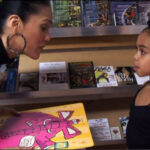Egyptian Dance, a captivating art form steeped in history and culture, holds a unique allure for enthusiasts worldwide. Rooted in the rich traditions of Egypt, these dances tell stories, express emotions, and connect generations. To delve deeper into this fascinating world, we had the pleasure of speaking with Mohamed Ali-Seven, the esteemed leader of the 7 Egyptian Dance Troupe. In this interview, Mohamed shares his personal journey, the challenges and triumphs of bringing Egyptian folkloric dance to the global stage, and offers valuable insights for those eager to explore this vibrant dance style.
From a young age, Mohamed’s fascination with dance ignited while watching television. He recalls eagerly awaiting any program that featured dance, allowing him to mimic the movements and immerse himself in the rhythm. This early passion led him to formal dance training at the age of 11, marking the beginning of his dedicated journey into the world of dance. His formal training provided a foundation, but it was a pivotal moment at 18 that truly shaped his path. Introduced by his cousin to the El Horrya Folk Dance Troupe in Alexandria, under the guidance of the renowned artist Nasreldin Mohamed, Mohamed stepped into the realm of Egyptian folkloric dance. This troupe, affiliated with the Egyptian Ministry of Culture, became his immersive training ground. He expanded his repertoire to include various folkloric styles and, at 24, embraced the mesmerizing Tanoura dance. This period marked not only intense learning but also global exposure, as Mohamed toured over 20 countries with the troupe. He participated in diverse cultural events, from festivals to competitions, in locations spanning France and India to Japan and the United States, broadening his understanding of dance as a global language.
Bringing Egyptian Folklore Dance to America: The Birth of 7 Egyptian Dance Troupe
Mohamed’s relocation to the United States in 2015 marked a new chapter, not just personally but also for his artistic vision. Driven by a desire to continue his performance of Egyptian folklore and share his deep-rooted culture, he established the 7 Egyptian Dance Troupe in 2016. This initiative was born from a passion to bridge cultures and bring the essence of Egypt to a new audience. Recognizing that physical travel to Egypt isn’t feasible for everyone, Mohamed envisioned his troupe as a means to transport the spirit and traditions of Egyptian dance to the US. He actively sought out dancers who resonated with this vision and were eager to learn the intricacies of Egyptian folkloric dance.
Challenges and Cultural Nuances in Egyptian Folkloric Dance
Establishing an Egyptian folkloric dance troupe in America presented unique challenges. One primary hurdle was finding dancers with the specific expertise required for folkloric styles. Unlike belly dance, which often incorporates improvisation, Egyptian folkloric dance demands precision and adherence to traditional steps and sequences. Mohamed faced the task of not only teaching the steps but also imparting the cultural context and background essential for authentic performance. This involved educating dancers, many of whom were not Egyptian, about the stories, traditions, and nuances embedded within each dance form.
Another initial challenge was securing performance opportunities and building an audience. Mohamed strategically targeted multicultural events and festivals to gain visibility. He leveraged the power of online platforms, sharing videos and performance highlights to cultivate interest in Egyptian folklore. In the early stages, the troupe undertook numerous performances pro bono, recognizing the need to build awareness and appreciation for Egyptian dance within the American cultural landscape.
Exploring the Diverse World of Egyptian Folkloric Dances
While Mohamed expresses a deep appreciation for all forms of Egyptian folkloric dance, he holds a special fondness for Eskandrani. This style, originating from his hometown of Alexandria, resonates deeply with his personal history and identity. Eskandrani dance reflects the vibrant, coastal culture of Alexandria, often incorporating playful and expressive movements. Beyond Eskandrani, Egyptian folklore encompasses a rich tapestry of dances, each with its own distinct character, costumes, and stories. From the energetic Saiidi dance of Upper Egypt to the graceful Ghawazee dance and the spiritual Tanoura, the diversity is immense. Each style offers a unique window into the different regions and traditions within Egypt.
Navigating Costumes in Egyptian Folkloric Dance
Costumes are integral to Egyptian folkloric dance, visually representing the traditions and stories being conveyed. Mohamed shares practical advice for dancers seeking authentic attire. He personally sources costumes during trips back to Egypt, often collaborating with designers to ensure both authenticity and timely creation. Planning ahead and communicating specific needs to designers in Egypt allows for a smoother process. For those unable to acquire costumes directly from Egypt, Mohamed recommends seeking out local designers who can be guided to create accurate and culturally respectful pieces. While local options exist, he notes that purchasing directly from Egypt often proves to be more straightforward and ensures a higher degree of authenticity.
The Enduring Significance of Learning Folkloric Dances
Mohamed articulates a powerful reason for the importance of learning folkloric dances: cultural preservation and dissemination. For him, these dances are not just movements; they are living embodiments of Egypt’s history and culture. Learning and performing folkloric dances becomes a vital act of sharing and perpetuating his heritage. This dedication to cultural transmission is at the heart of Mohamed’s work with the 7 Egyptian Dance Troupe, driving his passion to educate and engage audiences with the beauty and depth of Egyptian dance traditions.
 A vibrant performance showcasing the colorful costumes of Egyptian folkloric dance
A vibrant performance showcasing the colorful costumes of Egyptian folkloric dance
 Close-up detail of Egyptian dance costume elements
Close-up detail of Egyptian dance costume elements
 Dancers in motion, highlighting the dynamic energy of Egyptian dance
Dancers in motion, highlighting the dynamic energy of Egyptian dance
Mohamed Ali-Seven’s Vision for the Future of Egyptian Dance
Looking ahead, Mohamed envisions a continued dedication to his current path. His passion lies in teaching and sharing his extensive knowledge of Egyptian folkloric dance with a growing community. He values the opportunity to engage with students, answer their questions, and foster a deeper understanding of this art form. Mohamed aims to expand his reach through participation in more international festivals and workshops, alongside ongoing performances. His commitment to both performing and teaching underscores his holistic approach to promoting and preserving Egyptian dance.
Advice for Aspiring Egyptian Dancers
For those intrigued and wanting to embark on their own Egyptian dance journey, Mohamed offers practical guidance. He strongly recommends consistent, weekly classes with a qualified folkloric dance teacher. In-person instruction is particularly valuable for mastering technique and receiving personalized feedback. He also encourages students to seek opportunities to attend international dance festivals, immersing themselves in diverse styles and learning from various instructors. Furthermore, he acknowledges the wealth of online resources, particularly YouTube, where aspiring dancers can study performances by Egyptian folkloric dance groups to analyze technique and style. He emphasizes that folkloric dance is structured, with specific steps and traditions, making dedicated study and practice essential for authentic and respectful learning.


